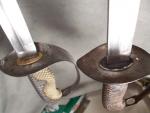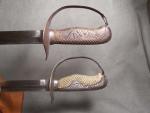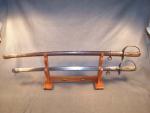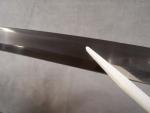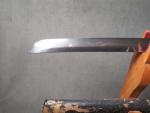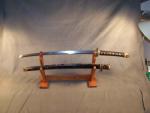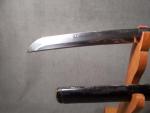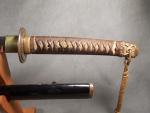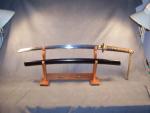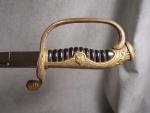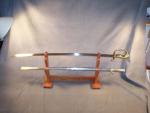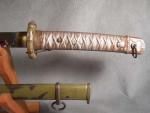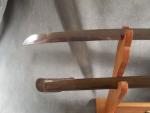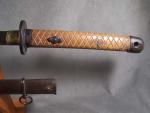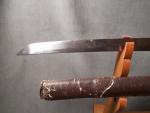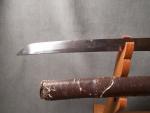-
Posts
6,486 -
Joined
-
Last visited
-
Days Won
10
Content Type
Profiles
Forums
Blogs
Gallery
Events
Store
Everything posted by Brian Wolfe
-
Hi Leigh, Different countries and different cultures. Here (in my little part of Ontario, Canada) I have found that female officers deal with a lot of crimes against women and children. Whether they are better at dealing with these victims than the male officers I can not say. I can say that the victims quite often would rather talk with a female officer, given that the antagonist is usually male. We like to think that everyone is equal regardless of gender but in the real world it is not always that clear cut and polical correctness takes a backseat to getting the job done. Maybe in the distant future our high ideals will become reality, we live in hope. Cheers Brian
-

Two Japanese Cavalry Sabres Type 32 c.1886
Brian Wolfe replied to Brian Wolfe's topic in Swords & Edged Weapons
Here is the last photo of my Type 32 sabres. This shows the short pattern with a brass washer and the long pattern with a leather washer. These washers were installed to keep moisture out of the saya (scabbard) while the sword was in the scabbard. The brass washer is the same style that was used on easlier swords prior to the Russo-Japanese War of 1904-05. It would be my guess that the use of the brass washer was discontinued due to the need for more swords during the war. This would make the short sabre an earlier pattern. The calvary sabre is used primarily as a replacement to the lance as well as providing a slashing weapon; the lance was not intended to be used as a slashing weapon. The fact that the later pattern (if I'm correct) is longer would make sence as the Army would want the longer sabre for battle. You don't need a long sabre if you are mainly involved in military parades. Any thoughts on on my hypothesis? Cheers Brian -

Two Japanese Cavalry Sabres Type 32 c.1886
Brian Wolfe replied to Brian Wolfe's topic in Swords & Edged Weapons
Here is the photo of the grip two of the Type 32 sabres. They look to be different in size but that is only due to my limited photographic skills. I have measured every aspect of these two sabres and the length seems to be the main difference. There is one other difference that I will show in the next photo. Brian -

Two Japanese Cavalry Sabres Type 32 c.1886
Brian Wolfe replied to Brian Wolfe's topic in Swords & Edged Weapons
Here is a photo that shows the relitave differences in the lengths of the sabres and the saya (scabbards). Brian -
Hello All, I am posting two Japanese Calvary Sabres Type 32 c.1886, one is longer than the other and I am wondering if this constitutes a different pattern. I will refer to them as the long and short pattern though this may technically be incorrect. It just makes this discussion easier and I hope clearer. The Cavalry Sabre Type 32 replaced the 1877 pattern in about 1866 and while a fairly scarce sword it is generally not sought after by collectors due to its utilitarial and non-Japanese appearance. The blades were machine made and the steel saya (scabbard) has one ashi (attachment ring). I have read that these were used during the Russo-Japanese War (1904-05) and up to the end of WW II. The top sword (long pattern) in the photo is the standard length for this pattern and is marked on the guard with the Koishikawa (Tokyo) Arsenal mark. It is numbered 73013 as is the saya. The bottom (short pattern) example is a full two inches shorter that the standard issue with the saya being 2 1/2 inches shorter. This has NOT been a shortened broken blade. The length from the tip to the fuller is the same on both as is the length of the area from the guard to the fuller. I have had sabres that were broken and then repaired but these were parade sabres and not meant for battle. The scabbard "drag" is the same length on both scabbards or saya and the throat of the scabbards vary only by the width of the throat reinforcement piece. The accountability number on the sabre is 66535 with the saya number being the same though it's an over-stamp which may indicate that the original saya had been damaged and replaced. The arsenal marks on this sabre look a lot like the Kure Naval Arsenal mark though I don't think it is. I would not expect to find a Naval Arsenal mark on a cavalry sabre, besides I believe that the Kure Arsenal turned out bayonets during WW II. The lower accountability number is not indicitive of an earlier manufacturer as the two arsenals or manufacturers may have numbered their products independently of one another. These were both purchased in the early 1970s. I say this because in 1985 a large number of similar swords were flooded onto the market by China. While these, at first glance, look like the Japanese Type 32 there are several obvious differences. I have owned one of these but soon traded it off as I felt it was an insult to the rest of my collection. Man, I'm taking my hobby way to seriously! If anyone has more infomation on these two sabres I would be most interested in hearing from you. Cheers Brian
-

Japanese Sword - Officer's Shin-gunto
Brian Wolfe replied to Brian Wolfe's topic in Swords & Edged Weapons
Now for the last photo, the Hamon (temper line). The Hamon is the line produced by the tempering of the blade. In this case the shape is called Sugu. This straight line is very diffucult to produce. The Hamon in the photo is half way between the plastic pointer and the Ha (cutting edge which is the upper most edge in the photo). It looks like the angle of the blade changes at the point of the Hamon but it is as smooth as glass. The area between the Hamon and the Ha (cutting edge) is called the Yakiba (tempered egde) and is easy to see in this photo. I hope the viewers are enjoying my Japanese sword collection, I'll post more on another day. Cheers Brian -

Japanese Sword - Officer's Shin-gunto
Brian Wolfe replied to Brian Wolfe's topic in Swords & Edged Weapons
The Kissaki (tip) of the Shin-gunto shown is the Chu shape. The photo does not show the Hamon (temper line) properly but it follows the shape of the edge all the way along to the Mune (back edge of the blade). Brian -

Japanese Sword - Officer's Shin-gunto
Brian Wolfe replied to Brian Wolfe's topic in Swords & Edged Weapons
This is a view of the Tsuba (guard). I find it interesting that this officer spent the cash on a fine blade yet went with a cheaper Tsuba. This was made to look like the pierced Tsuba with the separate Seppas (washers). There are Seppa used with this Tsuba but the other more decorative styles are part of the casting. It is possible that these were added after the war in order to offer a complete sword for the market. Complete swords do sell easier than the blade alone. That is unless you are talking about ancient blades then the furniture is not as important as the blade itself. Cheers Brian -

Japanese Sword - Officer's Shin-gunto
Brian Wolfe replied to Brian Wolfe's topic in Swords & Edged Weapons
Here is the Tsuka of my Officer's Shin-gunto. The Mekugi (bamboo peg) that attaches the blade to the Tsuka is actually too long but that is the way it was when I took over as its caretaker several years ago. Cheers Brian -
Hello All, Here is my Japanese Army Officer's Shin-gunto. It is a hand made blade and quite elegant in its design. The blade tappers along its length and the tip viewed from above the Mune (back edge of the sword) swells at the Kissaki (point). The Tsuka (handle) is also tappered and has a cast Tsuba (guard) which is solid and not pierced as many were. The Hamon (temper line) is straight which is technologically very difficult to achieve. This is an unnamed blade. Here are the particulars of this sword, Gendi Blade (1877 - 1945) Early Showa c. 1935 Nihunto Suguta (blade shape): Shinogi Zukuri Hamon (temper line): Sugu Kissaki (point): Chu Mune (back edge): Ihori Nakago (tang shape): Futsu Nakago-Jiri (tang tip): Kuri-jiri Yasurime-mei (file marks): Sujikai Makugi-ana: one The mounts are Shin-gunto c. 1943-44 This was not a run of the mill blade, though not an old family blade, and would have cost the officer considerable yen. Just a note on the Nakago (tang). If you are purchasing or have purchased a hand made blade and see that the Nakago has rusted do NOT remove this rust. It can be very important in dating an older blade. In fact removing the rust from the tang can devalue the blade considerably. Cheers Brian
-

Japanese Kai-gunto (Imperial Japanese Navy sword)
Brian Wolfe replied to Brian Wolfe's topic in Swords & Edged Weapons
-

Japanese Kai-gunto (Imperial Japanese Navy sword)
Brian Wolfe replied to Brian Wolfe's topic in Swords & Edged Weapons
Here is the tsuba. The tsuba (guard) of the Kai-gunto is made up of the tsuba and two seppa (washers) to give the familiar sun pattern of the Naval model sword hilt. Cheers Brian -

Japanese Kai-gunto (Imperial Japanese Navy sword)
Brian Wolfe replied to Brian Wolfe's topic in Swords & Edged Weapons
Here is the tsuka (hilt) of my Kai-gunto. The Same' (ray skin) has shrunk as the dealer who sold this to me had a fire in his shop and the heat shrunk the same'. There was no damage to the rest of the sword and I have never looked into replacing the same' as it is original and I like it that way. The tsuka-ito (binding) has seen a lot of handling most of which I would guess was post war. The menuki (metal ornaments under the tsuka-ito) are there to improve grip. Menuki are found on swords for all periods and if you check out the first sword of this series that I posted yesterday you'll see it even on the last swords of the war. You'll also see them on the oldest swords that I have yet to post. Cheers Brian -
Hello All, This is my Kai-gunto with the Naval tsuka (hilt). This blade is machine made of stainless steel and it is signed. The number 153 is also stamped into the nakago (tang). It is interesting to note that some machine made blades were signed and many hand made blade are unsigned, contrary to popular belief. Nakago shape: Futsu Nakago-jiri (tang tip shape): Kuri-jiri Mekugi-ana: one The tsuba (guard) is the brass and copper sun pattern of the Imperial Japanese Navy. I have read that most of these swords were lost with the ships on which their owners served. The sword would stay in the cabin while the officer was on duty. Naturally when the ship went down so did the Kai-gunto. There is reminents of a sword knot but these can not be trusted to tell the collector what rank the owner held. I would think that considering the actual knot is missing that this may be the original cord. The blade itself is quite nice though a little wider than I would expect near the ha-machi (area near the tsuka). It is one of my favourite swords in my small collection. I hope you like it as well. Cheers, Brian
-

Japanese Army Parade Sabre c. 1930
Brian Wolfe replied to Brian Wolfe's topic in Swords & Edged Weapons
And the acid etched blade. You can see the yakiba quite clearly and of course the hamon. This is the long pattern with a fullered blade. Cheers Brian -

Japanese Army Parade Sabre c. 1930
Brian Wolfe replied to Brian Wolfe's topic in Swords & Edged Weapons
Here is a close up of the grip and guard. On the side of the back strap can be seen the Japanese Mon (symbol). Sometimes an important family would have the family mon placed on the back of the back strap. If you are out looking to add one of these to your collection look at the back of the grip. If there is a mon and the price is fair, buy it. Unless I am there and then just point it out to me. This style of grip is not what most people expect when you talk about a WW II Japanese sword and indeed it is more like the grip style used during the Russo-Japanese War. I'll post one of those another day. Cheers, Brian -
Hello All, Here is the Japanese Army Parade Sabre c.1930, long pattern. The blade is machine made, chrome plated and with an acid etched yakiba. The yakiba is the tenpered part of the blade including the cutting edge. The line that is formed between the yakiba and the jigane (lower blade surface) is called the hamon. This feature could be purchased at an additional cost by the officer. These swords were not tempered and therefore would never have a naturally occuring hamon. As you can see this is only for parade duty as the blade would be of little use in a battle. The hand guard and grip style are along the European style, French influence I believe. The saya (scabbard) is chromed metal with one ashi. Neither the blade nor the scabbard are numbered. Cheers, Brian
-
Thanks Jim, I will post my officer's swords another day as well as my much older specimens. Two from the 1650s and a No-dachi that is probably an old copy as they have not made them since the 1390s. I got it in a trade with some other items many years ago. I'm listing the swords saving the best for last. Cheers Brian
-
-
Here is the NCO Shin-gunto c 1933-34 sword handle. Notice how much detail when into this handle to make it look like the original Samuri sword. I have seen this handle in copper but never owned one. I understand that there are fakes coming out of China or India that look exactly like these. If you are looking to purchase an original Shin-gunto be very cautious. If the condition looks too good to be true then it is almost always a fake. Cheers Brian
-
Hello All, Here is the NCO Shin-gunto c. 1933 -34 sword. This, in my opinion, is the sword most associated with the Japanese Army of the WW II period. This was designed to look like the Samuri swords of Japan's past. I think it was as much a propaganda item or perhaps an eccouragment to their young soldiers to follow Bushido as it was a functional battle sword. The sword itself has a nice feel and balance and is well made for a mass produced blade. The blade has a fuller, a feature dropped in later manufacture. The handle is well detailed and made of aluminum. It is attached to the blade by one brass screw. The blade and saya are both marked No. 132403. The blade has the Koishikawa Arsenal mark (pre 1936). The fuchi (copper collar just before the tsuba) has several markings. One I have not been able to identify but may belong to the Kokura Arsenal. The other marks are the Koishikawa Arsenal mark and what I believe to be an Army acceptance mark. The tsuba (hand guard) is brass and made to look like the traditional Samuri tsuba of long ago. The sword is held in the saya by a leaf spring catch. The saya is green painted metal with one ashi. Cheers Brian
-
-
-
Hello All, To continue with my Japanese sword theme here is an NCO Shin-gunto sword c. 1944. The blade is numbered 206811 and with what I believe to be the Seki acceptance mark. The saya is serial numbered the same as the blade and is made of brown painted steel with one ashi for attachment to the belt. The sword locks into the saya with a leaf spring catch. The handle is checkered wood and reflects the lack of metal in the period around the end of the war. The blade is machine made and lacks a fuller found on the earlier NCO sword (I'll post that one later). The blades on these are still of fair quality though not as fine as the earlier ones. Note that mass produced machine blades lack a true hamon (wavey line caused by quenching the blade during the process of hand forging). These have been called "Marine Landing Swords" as they were once thought, by western collectors, to have been issued to Japanese Marines when they were invading the different islands. I have read nothing to support that and in fact I have read just the opposite in that these were manufactured late in the war when there was a shortage of aluminum for the handle (as in the earlier NCO model). Please note that I do not refer to these as "WW II Samuri swords" as that is NOT what they are. The Samuri was outlawed in 1861(?) and therefore the term "WW II Samuri Sword" is totaly wrong. I hope you like this one, more later. Cheers Brian
-
Here is the tip of the sword. I tried to put this on a second ago but must have screwed it up. Brian



